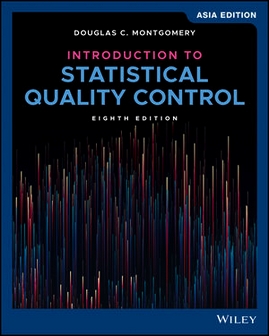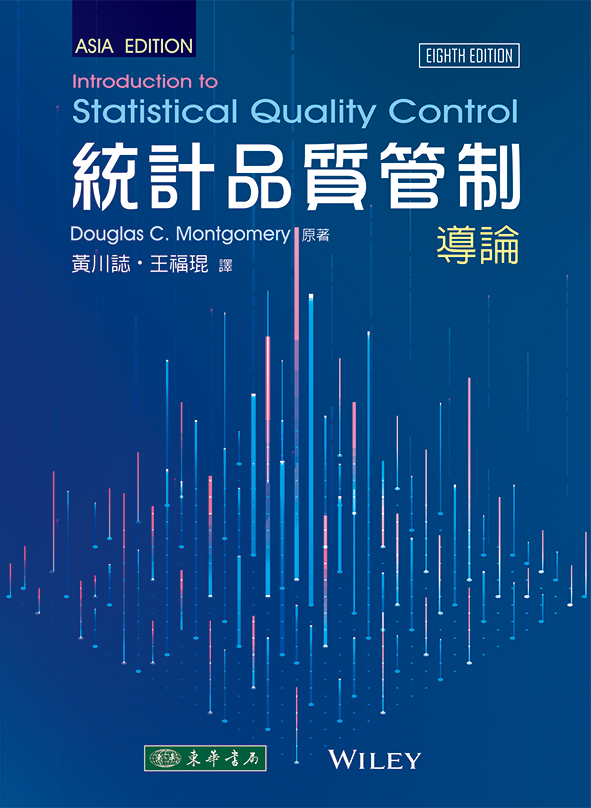書籍分類

Introduction to Statistical Quality Control 8/e
作者:Douglas C. Montgomery
原價:NT$ 1,850
ISBN:9781119657071
版次:8
年份:2020
出版商:John Wiley
頁數/規格:760頁/平裝雙色
參考網頁:Introduction to Statistical Quality Control 8/e
版次:8
年份:2020
出版商:John Wiley
頁數/規格:760頁/平裝雙色
參考網頁:Introduction to Statistical Quality Control 8/e
內容介紹 本書特色 目錄
- CHAPTER ORGANIZATION AND TOPICAL COVERAGE
The book contains five parts. Part 1 is introductory. The first chapter is an introduction to the philosophy and basic concepts of quality improvement. It notes that quality has become a major business strategy and that organizations that successfully improve quality can increase their productivity, enhance their market penetration. and achieve greater profitability and a strong competitive advantage. Some of the managerial and implementation aspects of quality improvement are included. Chapter 2 describes DMAIC, an acronym for Define, Measure, Analyze, Improve, and Control. The DMAIC process is an excellent framework to use in conducting quality-improvement projects. DMAIC often is associated with Six Sigma, but regardless of the approach taken by an organization strategically9 DMAIC is an excellent tactical tool for quality professionals to employ.
Part 2 is a description of statistical methods useful in quality improvement. Topics include sampling and descriptive statistics, the basic notions of probability and probability distributions. point and interval estimation of parameters. and statistical hypothesis testing. These topics are usually covered in a basic course in statistical methods: however, their presentation in this text is from the quality-engineering viewpoint. My experience has been that even readers with a strong statistical background will find the approach to this material useful and somewhat different from a standard statistics textbook.
Part 3 contains four chapters covering the basic methods of statistical process control (SPC) and methods for process capability analysis. Even though several SPC problem-solving tools are discussed (including Pareto charts and cause-and-effect diagrams. for example), the primary focus in this section is on the Shewhart control chart. The Shewhart control Chart certainly is new, but its use in modern-day business and industry is of tremendous value.
There are four chapters in Part 4 that present more advanced SPC methods Included are the cumulative sum and exponentially weighted moving average control charts (Chapter 9), several important univariate control charts such as procedures for short production runs, autocorrelated data, and multiple stream processes (Chapter 10), multivariate process monitoring and control (Chapter 11), and feedback adjustment techniques (Chapter 12). Some of this material is at a higher level than Part 3, but much of it is accessible by advanced undergraduates or first-year graduate students. This material forms the basis of a second course in statistical quality control and improvement for this audience.
Part 5 contains two chapters that show how statistically designed experiments can be used for process design. development, and improvement. Chapter 13 presents the fundamental Concepts of designed experiments and introduces factorial and fractional factorial designs, with particular emphasis on the two-level system of designs. These designs are used extensively in the industry for factor screening and process characterization. Although the treatment of the subject is not extensive and is no substitute for a formal course in experimental design, it will enable the reader to appreciate more sophisticated examples of experimental design. Chapter 14 introduces response surface methods and designs. illustrates evolutionary operation (EVOP) for process monitoring, and shows how statistically designed experiments can be used for process robustness studies Chapters 13 and 14 emphasize the important interrelationship between statistical process control and experimental design for process improvement.
Two chapters deal with acceptance sampling in Part 6. The focus is on lot-by-lot acceptance sampling, although there is some discussion of continuous sampling and MIL STD 1235C in Chapter 14. Other sampling topics presented include various aspects of the design of acceptance-sampling plans, a discussion of MIL STD 105E, and MIL STD 414 (and their civilian counterparts: ANSI/ASQC ZI.4 and ANSI/ASQC ZI.9), and other techniques such as chain sampling and skip-lot sampling.
Throughout the book, guidelines are given for selecting the proper type of statistical technique to use in a wide variety of situations. In addition, extensive references to journal articles and other technical literature should assist the reader in applying the methods described. I also have shown how the different techniques presented are used in the DMAIC process.





